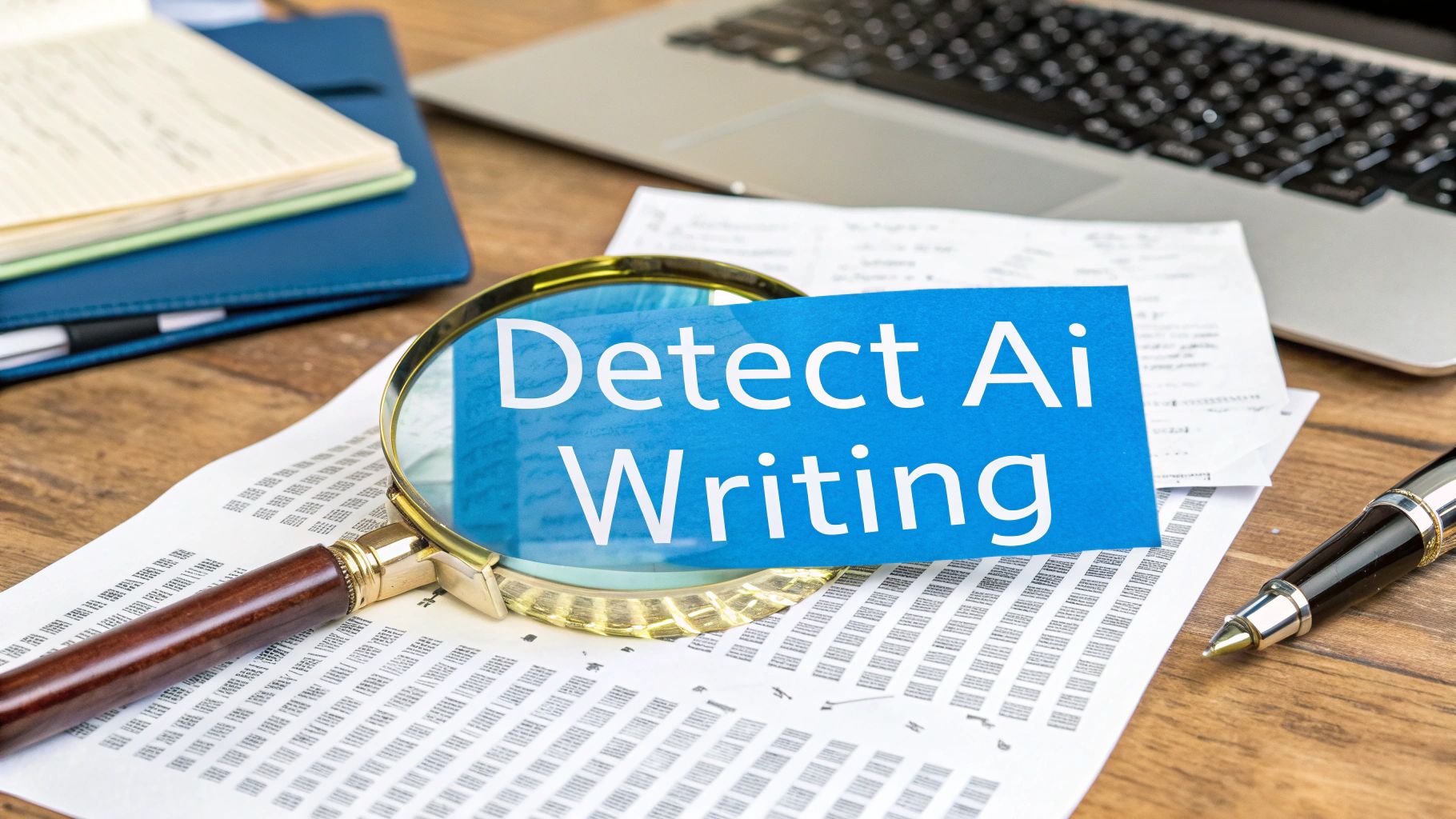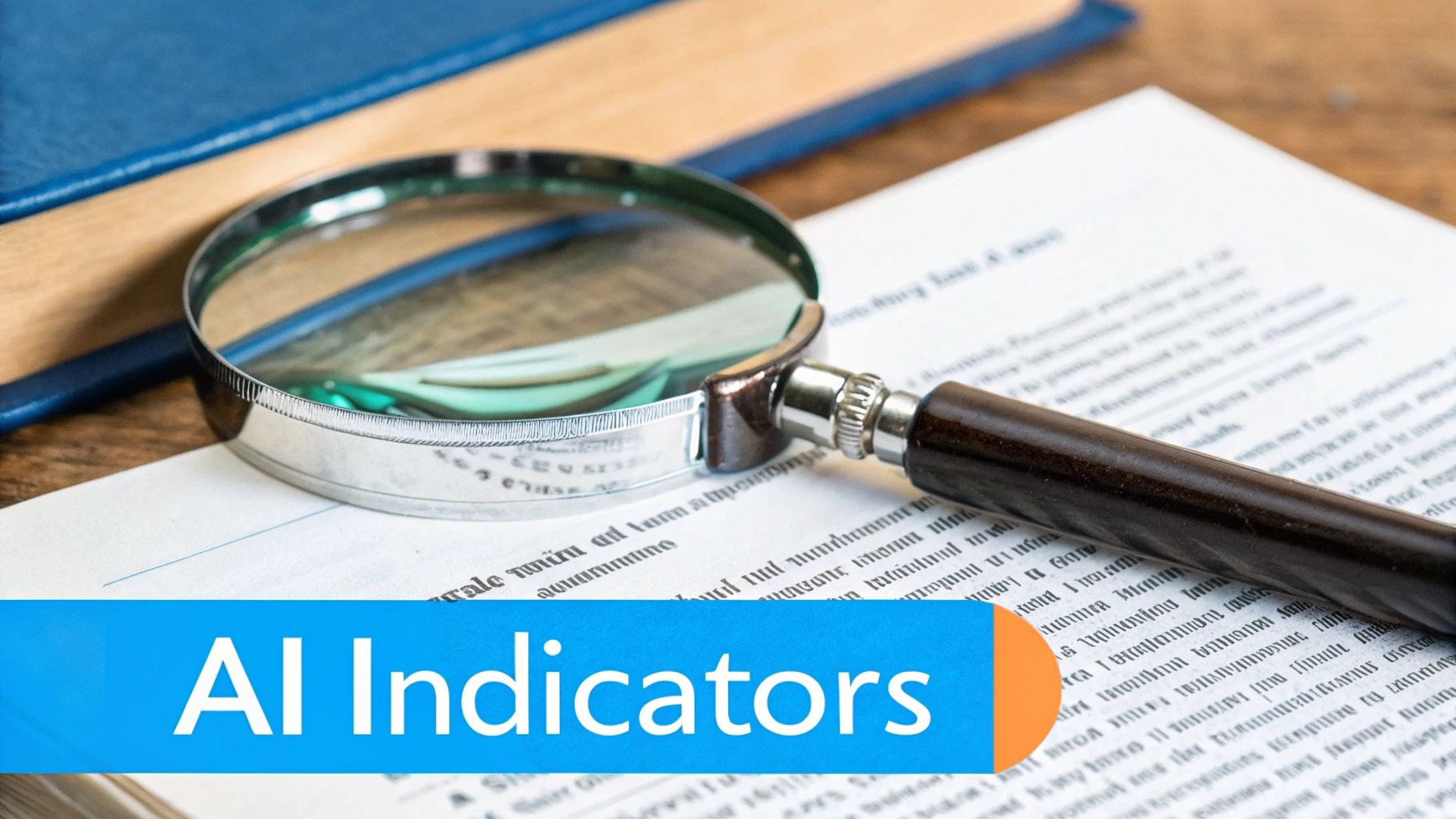How to Reliably Detect AI Writing

The most reliable way to detect AI writing isn't about finding a magic-bullet tool. It’s about creating a hybrid approach that combines the power of advanced detection software with your own critical judgment. Relying on just one method simply isn't enough anymore; the best and most accurate assessments come from blending technology with good old-fashioned human insight.
The Growing Need to Identify AI Content
With the explosion of generative AI, being able to spot machine-written text has become an essential skill for almost everyone. This isn't just for editors and marketers; it's a critical new literacy for educators and students, too. What used to be easy to spot—think robotic tones and clunky phrasing—has evolved into something much more sophisticated and harder to distinguish from human writing.
This isn't some niche problem, either. AI is now a core part of the content creation workflow for countless professionals. Recent statistics show that 71.7% of content marketers use AI for tasks like outlining, and a staggering 57.4% use it for drafting content. These aren't just fringe numbers; they show just how deeply AI is woven into the fabric of modern content production.
Why Detection Matters More Than Ever
The game has changed. It's no longer about catching poorly written bots, but about protecting authenticity in a world flooded with AI-assisted content. For businesses, this means preserving a unique brand voice that connects with customers. For academics, it’s about upholding integrity and ensuring students are actually learning.
This is a major concern, especially as academic platforms tighten their scrutiny. A common question I hear from both students and educators is if services like Turnitin can detect AI, which shows just how high the stakes have become.
The real challenge we're facing with the rise of AI-generated content is a fundamental need for transparency. Fostering trust in these systems is crucial as we navigate this new digital reality.
At the end of the day, learning to detect AI writing is all about trust. The models are so good now that even well-written human content can get flagged by overly sensitive tools, creating a fog of skepticism. By learning the signs and using the right tools, we can restore that confidence and continue to value and verify genuine human expression. That's why building AI trust through understanding has become such a vital conversation.
So, you need to spot AI-generated content. Where do you even begin? Picking an AI detector isn't as straightforward as grabbing the first one you find on Google. There are dozens of options out there, all claiming near-perfect accuracy, and the truth is, the "best" tool really depends on what you're doing.
An educator trying to verify student assignments has totally different needs than a marketer trying to protect their brand's voice online.
The tools themselves vary wildly. Some are trained to sniff out text from specific models like GPT-4 or Claude, while others cast a wider net. They also differ in how much text you can check for free and, importantly, what they do with your data. A detector that's great at flagging a formulaic college essay might completely miss the mark on a piece of marketing copy.
What to Look for in an AI Detector
When you're trying to detect AI writing, a few key features should be on your radar. Accuracy is obviously the big one, but it’s a bit of a moving target since AI models are constantly getting smarter. Look for tools that are transparent about how they score content.
My advice? Avoid any tool that just gives you a single percentage. You need more context than that.
The most effective AI detectors don't just give you a simple "yes" or "no." They break down the text, often highlighting specific sentences that seem fishy. This gives you the power to understand why something was flagged, so you can make an informed call instead of just blindly trusting a score.
A clean, easy-to-use interface is also a huge plus. If you have to fight with the dashboard just to get a clear result, you'll waste a ton of time.
This chart really puts into perspective why these tools have become so essential. It compares the sheer volume of AI content out there against the average accuracy of detection tools versus human reviewers.
As you can see, while AI detectors aren't flawless, their average accuracy of 90% is significantly higher than the 75% accuracy of human reviewers. This makes them an invaluable part of any serious content verification workflow.
Comparing Top AI Content Detectors
To help you sort through the options, here’s a quick comparison of some of the leading AI detection tools on the market. This table breaks down their features to help you find the right fit based on what matters most to you: accuracy, cost, or a specific use case.
| Tool Name | Reported Accuracy | Key Feature | Best For |
|---|---|---|---|
| Detecting-AI | 99% | Sentence-level highlighting | Educators and publishers |
| Originality.AI | 99% | Plagiarism + AI check | SEO agencies and content marketers |
| Winston AI | 99.6% | Document uploads and team features | Academic institutions and businesses |
| Copyleaks | 99.1% | Multi-language support | Global companies and multilingual content |
Ultimately, the best choice depends on your specific workflow. For a quick, one-off check, a free tool might be enough. But for ongoing, high-stakes verification, a paid solution with detailed reporting is well worth the investment.
Accuracy Claims and Real-World Performance
You'll see a lot of bold accuracy claims out there. And some of them are backed by solid data. For example, a top-tier solution like Detecting-ai.com’s Detector V2 reported a 99% accuracy rate in identifying AI-generated text, which was confirmed by independent RAID benchmarks. That kind of performance comes from being trained on enormous datasets covering all the major language models.
But here’s the reality check: no tool is perfect. False positives happen, especially with human writing that is very structured or polished. It's just the nature of the beast.
For niche tasks, like keeping an eye on your company's reputation, you might even want to look beyond general-purpose detectors. There are specialized platforms for tracking LLM-generated brand mentions that offer a more focused approach.
From my experience, the smartest strategy is to use two tools. Have a primary detector you trust, and if you get a result that feels off, run the text through a second one. This "trust but verify" approach helps confirm your suspicions and drastically reduces the chance of making a bad call based on a single, potentially flawed, data point.
Using Human Insight to Spot AI Content
While AI detection tools give you a useful data point, they’re no substitute for your own critical judgment. Technology can absolutely be fooled, but a trained human eye can often catch the subtle giveaways that algorithms miss. This isn't just about spotting robotic phrases; it's about recognizing a fundamental lack of human depth.
Think of it this way: an AI can follow the blueprint for a good story, but it can’t invent a genuine memory. It stumbles when it comes to adding personal anecdotes, unique opinions, or firsthand experiences simply because it doesn’t have any. The content might feel polished and clean, but it's also hollow—like a perfectly staged home that no one has ever lived in.
This absence of an authentic perspective is a massive red flag.
Look for Signs of Algorithmic Polish
Ironically, one of the biggest tells of AI-generated content is that it can be too perfect. Even the most skilled human writers have a certain rhythm, a natural imperfection to their work. AI-generated text, on the other hand, often has an uncanny, almost sterile, flawlessness.
A recent article highlighted a strange paradox: the clearer and more structured a piece of writing is, the more likely some AI detectors are to label it artificial. In a bizarre twist, well-prompted AI writing is sometimes judged as more human than actual human writing.
This means you need to shift what you’re looking for. Instead of just scanning for obvious errors, start looking for that overly consistent, sterile quality.
Common Giveaways to Watch For
Here are a few specific patterns I've learned to watch for that often signal a machine's hand at work:
- Repetitive Sentence Starters: Does the text start several sentences in a row with the same transition words? Phrases like "Additionally," "Furthermore," and "In conclusion" are classic AI crutches.
- Vague Generalities: AI is a master of producing content filled with generic platitudes and well-known facts. If it’s all surface-level information without a unique angle or deeper insight, be suspicious.
- Inconsistent Tone: You might see the writing jump from a formal, academic tone to a casual one for no apparent reason. This often happens when different sections were generated with separate prompts.
- Factual Hallucinations: This one is critical. Always double-check any specific claims, statistics, or historical facts. AI is notorious for confidently inventing "facts" that sound completely plausible but are flat-out wrong.
What to Do with a High AI Detection Score
Getting a high AI detection score can feel like a red flag, but it's important to remember what it really is: a starting point for investigation, not a final verdict. These tools aren’t delivering a definitive judgment; they're giving you a probability score based on patterns.
This is a critical distinction. I’ve personally seen exceptionally clear, well-structured human writing trigger a false positive. Sometimes, a clean, logical argument can look too perfect to an algorithm, which then flags it as artificial. This often happens to writers who naturally produce highly structured prose, a style that can unintentionally mimic the predictable output of some AI models. That's why jumping to conclusions based on one number is a mistake.
Your Next Steps After a High Score
So, what should you actually do? Your first move should always be to verify the result. Never trust a single tool’s opinion. Run the text through a completely different AI detector to see if you get a similar score. This simple cross-check can tell you pretty quickly if the initial flag was just an anomaly or a consistent pattern that needs a closer look.
The performance between different tools can be worlds apart. For instance, a recent case study testing GPT-4o found an average detection rate of 85.27% across a range of detectors. However, a specialized tool like Originality AI hit a 100% detection rate on some of the same AI-generated samples. You can dive deeper into these performance gaps in the full AI detection case study.
A high AI score is an invitation to look closer, not a reason to press the panic button. Use it as a signal to engage your own human insight and investigate the content with a more critical eye.
If you’re still seeing high scores across multiple platforms, it’s time to switch to manual analysis. Go back to the fundamentals and look for those classic AI giveaways—things like repetitive phrasing, a complete lack of personal voice, or even factual errors. And always, always consider the context. Is this a piece where a formulaic structure makes sense, or is it supposed to have a distinct, personal touch? Our guide on whether people can detect AI writing offers more hands-on tips for this manual process.
Taking this measured, multi-step approach is the only way to detect AI writing fairly and accurately, helping you maintain trust whether you're in a classroom or a professional setting.
Creating Original Content in the Age of AI
All this talk about detecting AI writing often sidesteps the bigger picture. If you're a creator, marketer, or academic, your real mission isn't just about slipping past a detection tool—it's about creating valuable, original work that actually connects with people and gets results.
The focus needs to shift from simply "passing the test" to making something a machine could never dream up on its own. AI is a brilliant assistant for brainstorming ideas, handling initial research, or busting through a bout of writer's block. It can give you a solid outline or a starting draft, but that's where its role should end. The soul of your work has to come from you.
Leaning into E-E-A-T and Genuine Human Insight
This is where Google's E-E-A-T (Experience, Expertise, Authoritativeness, and Trustworthiness) guidelines become so important. They're designed to reward content that shows a real, firsthand perspective—something only a human can truly provide.
To make your content stand out and feel genuinely human, you have to:
- Weave in Personal Stories: Share those unique anecdotes, case studies, or personal experiences that an AI simply can't invent. This is your unique fingerprint on the content.
- Cultivate a Distinct Voice: Develop a writing style and tone that is unmistakably yours or your brand's. A consistent voice builds familiarity and trust with your audience over time.
- Offer Fresh Perspectives: Don't just rehash what everyone else is saying. Find a new angle, challenge a common belief, or provide a deeper analysis that adds real value for the reader.
The best way to make content feel human is to make sure it is human. AI can’t fake lived experience or a truly original thought. When you build your content on these foundations, it not only becomes more engaging but also naturally harder for any tool to flag as artificial.
Using AI ethically means playing to its strengths without letting it do your critical thinking for you. For anyone trying to master this new landscape, learning how to avoid AI detection in writing is less about tricking software and more about perfecting the art of blending machine assistance with human creativity. By prioritizing authentic, experience-driven content, you'll end up creating work that both people and search engines love.
Got Questions About AI Detection? We’ve Got Answers.
As detecting AI writing becomes a bigger part of our world, a lot of questions pop up. It's a new frontier for many, so let's walk through some of the most common ones I hear from clients and colleagues.
One of the first things people ask is if AI detectors can really be bypassed. The quick answer? Sometimes, but it’s a constant cat-and-mouse game and getting tougher by the day. There are tools out there, often called "humanizers" or "paraphrasers," that promise to rewrite AI text to sound more human.
While some might sneak past a basic detector, the best-in-class tools are always updating their algorithms to spot exactly this kind of manipulation. Relying on those bypass tools is a risky bet.
What Does an AI Score Actually Mean?
Another big question is about the AI score itself—what’s a "good" or "bad" number? Honestly, there’s no magic number that fits every situation. A 10% AI likelihood on a deeply personal, creative poem is way more alarming than a 30% score on a dry, highly structured technical report. Context is everything.
The real key is to set your own standards based on why the content exists in the first place. If you're writing a personal blog post to build a brand around your unique voice, you’ll want a score as close to zero as possible. But for something like an internal data summary, a higher score might be completely fine.
Do These Tools Work for Other Languages?
Finally, I get a lot of questions about accuracy across different languages. While many of the top-tier detectors now support multilingual analysis, their performance can definitely vary.
Most models have been trained most heavily on English text. That means their accuracy and nuance might be slightly lower when you feed them content in other languages. It's always smart to double-check a tool’s specific language capabilities before you rely on it.
Instead of just trying to trick a tool, a much better approach is learning how to make your text not seem AI-generated by improving its originality. This proactive mindset is about injecting genuine human insight and a unique voice—which is, and always will be, the ultimate defense.
Ready to check your content's authenticity and polish its voice? Word Spinner offers an integrated AI Detector and powerful humanizing tools to make sure your writing is original, engaging, and sounds like you. Try it for free today!



